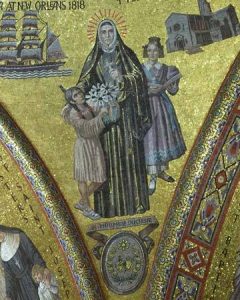 St. Rose Philippine Duchesne (1769–1852) was born in Grenoble, France, to a wealthy and prominent family. At the age of 18 she joined the Visitation nuns against the wishes of her family, taking her religious name after St. Rose of Lima and St. Philip Neri. During the anti-religious fervor of French Revolution, the “Reign of Terror,” her convent was shut down. She then took up the work of providing care for the sick, hiding priests from the revolutionaries, and educating homeless children.
St. Rose Philippine Duchesne (1769–1852) was born in Grenoble, France, to a wealthy and prominent family. At the age of 18 she joined the Visitation nuns against the wishes of her family, taking her religious name after St. Rose of Lima and St. Philip Neri. During the anti-religious fervor of French Revolution, the “Reign of Terror,” her convent was shut down. She then took up the work of providing care for the sick, hiding priests from the revolutionaries, and educating homeless children.
When the tensions of the revolution subsided, she rented out her old convent in an attempt to revive her religious order, but the spirit was gone. She and the few remaining nuns of her convent then joined the Society of the Sacred Heart of Jesus (founded in 1800). Since childhood St. Rose Philippine had had a strong desire to be a missionary in the New World, and encouraged by her spiritual father, she wanted to work especially among the Native Americans. Like the Apostles sent by the Lord, she was sent by the Society to go on mission in 1818; she and four nuns traveled across the Atlantic, up the Mississipi river to serve in one of the remotest outposts in the region in St. Charles, Missouri.
The vocation St. Rose had was for a blend of the contemplative life and the missionary life: a contemplative in action, like that of the Society of Jesus. St. Rose Philippine was a hardy pioneer woman ministering in the Midwest during its difficult frontier days. She opened several schools and served the Potawatomi Indians who gave her the name “Quah-kah-ka-num-ad,” meaning, “Woman-who-prays-always.”
St. Rose Philippine followed the example the foundress of the Sacred Heart Society, trusting completely in God with boldness and completeness that would saturate her whole life and mission. Her mission, like that of St Paul, was realized in “the power now at work in us can do immeasurably more than we can ask or imagine.” (Ephesians 3:20)
At the age of 83 St. Rose Philippine on this date. She was canonized on July 3, 1988 by St. John Paul II. (edited DG)


